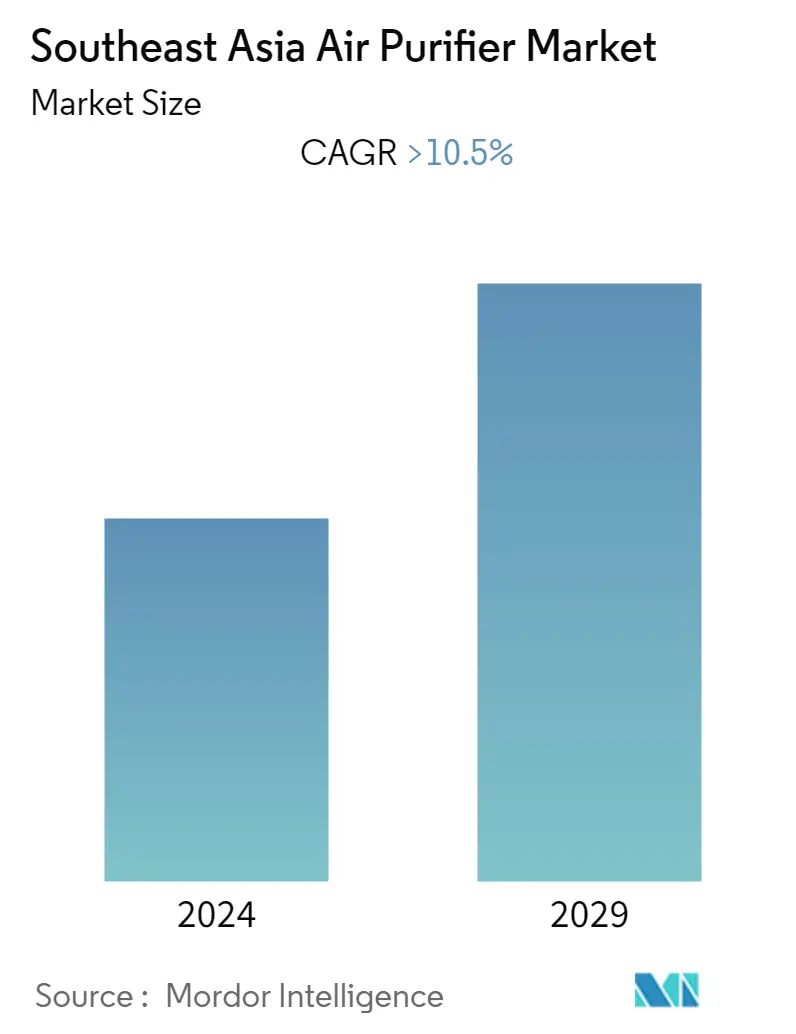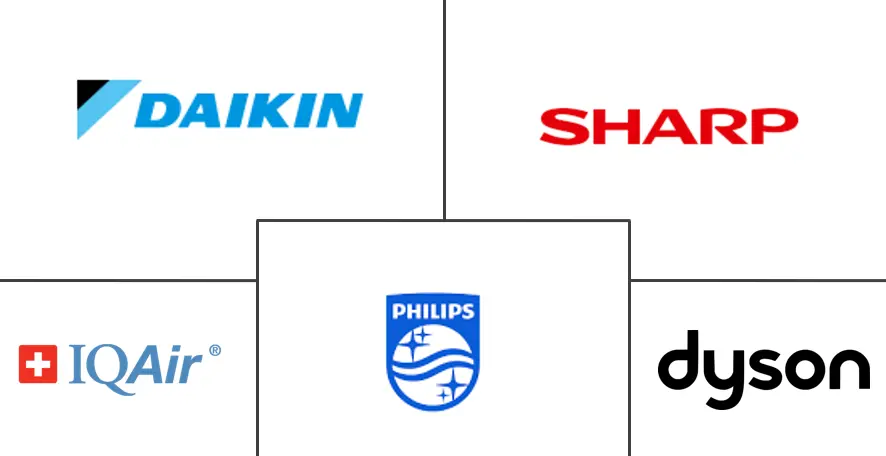Market Size of Southeast Asia Air Purifier Industry

| Study Period | 2019 - 2029 |
| Base Year For Estimation | 2023 |
| Forecast Data Period | 2024 - 2029 |
| Historical Data Period | 2019 - 2022 |
| CAGR | > 10.50 % |
| Market Concentration | Low |
Major Players
*Disclaimer: Major Players sorted in no particular order |
Southeast Asia Air Purifier Market Analysis
The Southeast Asia air purifier market is expected to register a CAGR of greater than 10.5% during the forecast period.
The outbreak of COVID-19 had a negative effect on the market. Currently, the market has reached pre-pandemic levels.
- Factors such as increasing airborne diseases and growing health consciousness among consumers are driving the market. Air pollution from industries is constantly emerging as a big threat to the health of individuals as well as the environment. Due to deteriorating air quality and rising concerns about health issues, the demand for air purifiers has increased in recent years.
- Despite the various technological developments, air purifiers have been perceived as a luxury item in both underdeveloped and emerging economies, particularly in the commercial and residential segments, owing to the high installation and maintenance costs. This, in turn, is expected to hinder the growth of the market studied during the forecast period.
- Technological advancements and upgrades in developing air purifier systems are expected to create immense opportunities for the Southeast Asian air purifier market in the coming years.
- With sales of air purifiers increasing by several folds due to the public's increasing adoption of air purifiers, Indonesia is expected to dominate the market during the forecast period.
Southeast Asia Air Purifier Industry Segmentation
An air purifier or air cleaner is a device that removes contaminants from the air in a room to improve indoor air quality. The Southeast Asian air purifier market is segmented by filtration technology, type, end-user, and geography. By filtration technology, the market is segmented into high-efficiency particulate air (HEPA) and other filtration technologies. By type, the market is segmented into stand-alone and in-duct systems. By end-user, the market is segmented into residential, commercial, and industrial. The report also covers the market size and forecasts for the air purifier market across the major countries in the region. For each segment, market sizing and forecasts have been done based on revenue (USD billion).
| Filtration Technology | |
| High-efficiency Particulate Air (HEPA) | |
| Other Filtration Technologies (Electrostatic Precipitators (ESPs), Ionizers and Ozone Generators, etc.) |
| Type | |
| Stand-alone | |
| In-duct |
| End-User | |
| Residential | |
| Commercial | |
| Industrial |
| Geography | |
| Indonesia | |
| Malaysia | |
| Thailand | |
| Vietnam | |
| Philippines | |
| Singapore | |
| Rest of Southeast Asia |
Southeast Asia Air Purifier Market Size Summary
The Southeast Asia air purifier market is poised for significant growth, driven by increasing health consciousness and the rising prevalence of airborne diseases. The demand for air purifiers has surged due to deteriorating air quality and heightened concerns about health issues stemming from industrial pollution. Despite technological advancements, air purifiers are often viewed as luxury items in emerging economies, which poses a challenge to market expansion. However, ongoing technological upgrades in air purification systems are expected to create substantial opportunities for market growth. Indonesia is anticipated to lead the market, fueled by its high pollution levels and increasing adoption of air purifiers.
The market is characterized by a fragmented landscape with key players such as Daikin Industries, Sharp Corporation, Koninklijke Philips N.V., IQAir, and Dyson Ltd. The demand for high-efficiency particulate air (HEPA) filters is expected to dominate, driven by their effectiveness in removing airborne particles and their widespread application in industrial and commercial spaces. The introduction of advanced HEPA filters with integrated technologies is likely to further boost demand. Indonesia's significant pollution challenges, exacerbated by factors like coal-fired power plants and urban development, underscore the growing need for air purifiers, positioning the country as a dominant force in the Southeast Asian market.
Southeast Asia Air Purifier Market Size - Table of Contents
-
1. MARKET OVERVIEW
-
1.1 Introduction
-
1.2 Market Size and Demand Forecast in USD billion, till 2028
-
1.3 Recent Trends and Developments
-
1.4 Government Policies and Regulations
-
1.5 Market Dynamics
-
1.5.1 Drivers
-
1.5.2 Restraints
-
-
1.6 Supply Chain Analysis
-
1.7 Porter's Five Forces Analysis
-
1.7.1 Bargaining Power of Suppliers
-
1.7.2 Bargaining Power of Consumers
-
1.7.3 Threat of New Entrants
-
1.7.4 Threat of Substitute Products and Services
-
1.7.5 Intensity of Competitive Rivalry
-
-
-
2. MARKET SEGMENTATION
-
2.1 Filtration Technology
-
2.1.1 High-efficiency Particulate Air (HEPA)
-
2.1.2 Other Filtration Technologies (Electrostatic Precipitators (ESPs), Ionizers and Ozone Generators, etc.)
-
-
2.2 Type
-
2.2.1 Stand-alone
-
2.2.2 In-duct
-
-
2.3 End-User
-
2.3.1 Residential
-
2.3.2 Commercial
-
2.3.3 Industrial
-
-
2.4 Geography
-
2.4.1 Indonesia
-
2.4.2 Malaysia
-
2.4.3 Thailand
-
2.4.4 Vietnam
-
2.4.5 Philippines
-
2.4.6 Singapore
-
2.4.7 Rest of Southeast Asia
-
-
Southeast Asia Air Purifier Market Size FAQs
What is the current Southeast Asia Air Purifier Market size?
The Southeast Asia Air Purifier Market is projected to register a CAGR of greater than 10.5% during the forecast period (2024-2029)
Who are the key players in Southeast Asia Air Purifier Market?
Daikin Industries, Ltd., Sharp Corporation, IQAir, Koninklijke Philips N.V. and Dyson Ltd are the major companies operating in the Southeast Asia Air Purifier Market.

